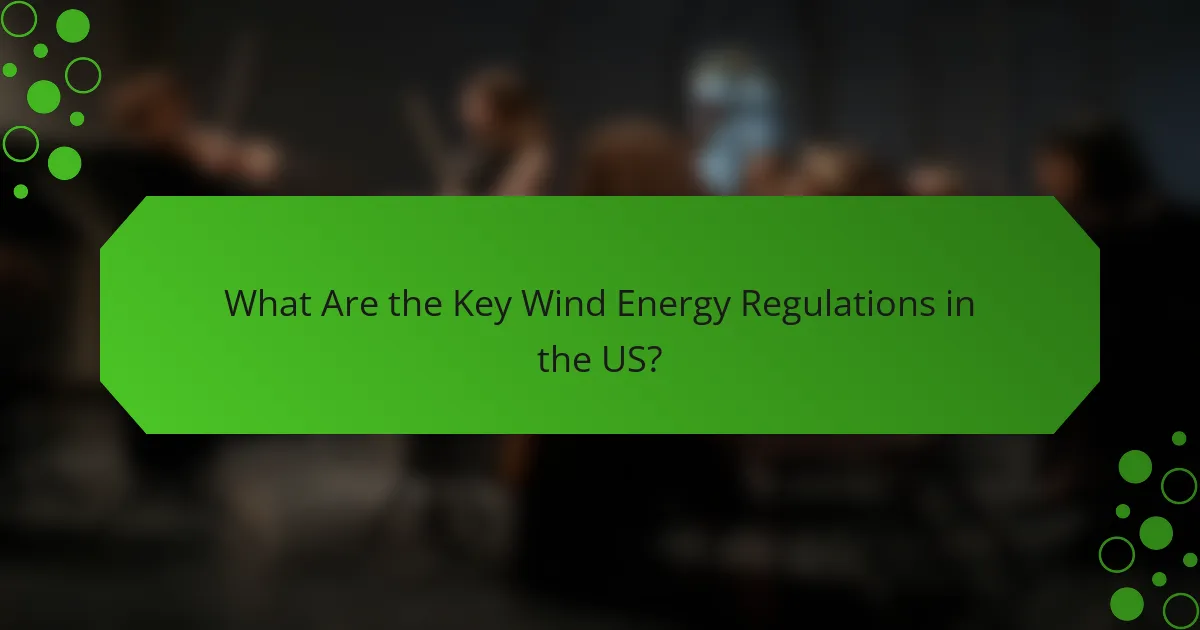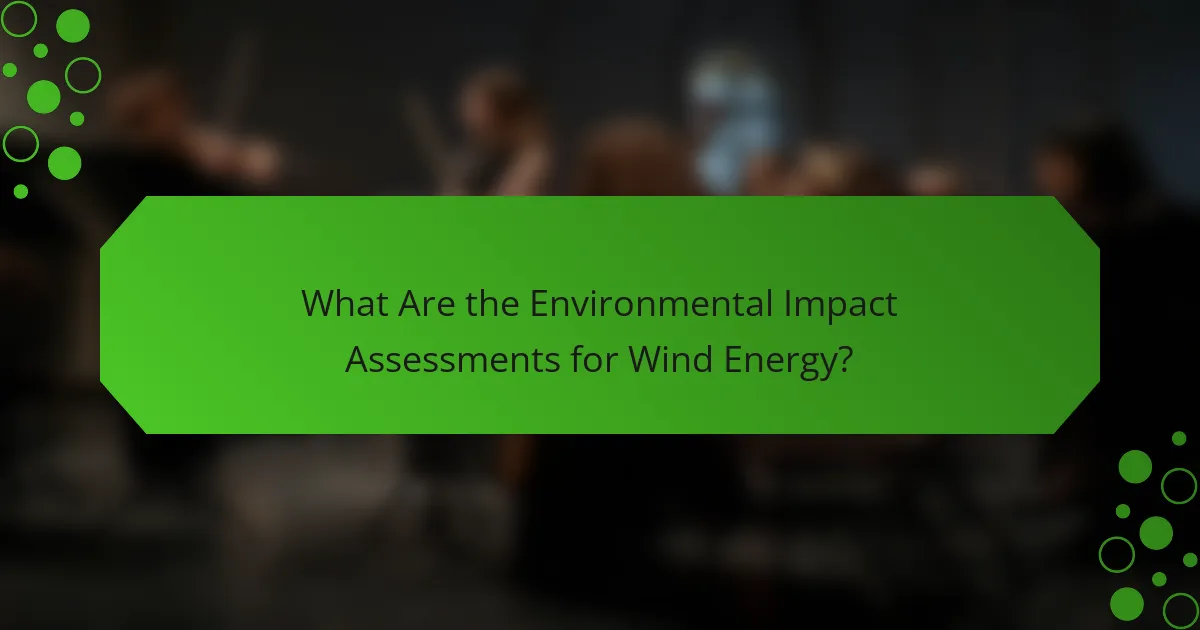Wind energy regulations in the US encompass a comprehensive framework of federal, state, and local guidelines that govern the development and operation of wind energy projects. These regulations are designed to ensure compliance with safety, environmental, and operational standards while fostering the growth of renewable energy sources. Understanding and adhering to these diverse regulations is crucial for developers to navigate the complexities of site selection, environmental impact assessments, and community engagement effectively.

What Are the Key Wind Energy Regulations in the US?
The key wind energy regulations in the US encompass federal, state, and local guidelines that govern the development and operation of wind energy projects. These regulations ensure compliance with safety, environmental, and operational standards while promoting the growth of renewable energy sources.
Federal Energy Regulatory Commission (FERC) guidelines
The Federal Energy Regulatory Commission (FERC) sets essential guidelines for the transmission and sale of electricity generated from wind energy. These regulations include requirements for interconnection agreements, which outline how wind farms connect to the power grid, and they ensure fair access to transmission lines.
FERC also oversees the wholesale electricity market, which impacts how wind energy is priced and sold. Developers must understand these guidelines to navigate the regulatory landscape effectively and maximize their project’s profitability.
State-specific wind energy laws
Each state in the US has its own set of laws and regulations governing wind energy development, which can vary significantly. These laws may include renewable portfolio standards (RPS), which require utilities to obtain a certain percentage of their energy from renewable sources, including wind.
Additionally, states may offer incentives such as tax credits or grants to encourage wind energy projects. It is crucial for developers to research and comply with their specific state’s regulations to avoid legal issues and to take advantage of available support.
Local zoning and permitting requirements
Local governments impose zoning and permitting requirements that can significantly affect wind energy projects. These regulations often dictate where wind farms can be located, the height of turbines, and the distance from residential areas. Developers must engage with local authorities early in the planning process to ensure compliance.
Obtaining the necessary permits can be a lengthy process, often requiring public hearings and environmental assessments. Understanding local guidelines and community concerns is vital to successfully navigate this phase and avoid delays or rejections.

How to Ensure Compliance with Wind Energy Standards?
To ensure compliance with wind energy standards, it is essential to understand and adhere to the relevant regulations and guidelines set by recognized organizations. This involves familiarizing yourself with national standards and local regulations that govern the installation and operation of wind energy systems.
Understanding National Renewable Energy Laboratory (NREL) standards
The National Renewable Energy Laboratory (NREL) provides crucial standards that guide the design and implementation of wind energy projects. These standards focus on performance, safety, and environmental impact, ensuring that projects align with national goals for renewable energy.
Key considerations include evaluating site conditions, turbine specifications, and energy production forecasts. Following NREL standards can help in obtaining necessary permits and ensuring that projects meet federal and state regulations.
Adhering to American Wind Energy Association (AWEA) guidelines
The American Wind Energy Association (AWEA) offers guidelines that help developers and operators maintain best practices in the wind energy sector. These guidelines cover a range of topics, including turbine design, safety protocols, and operational efficiency.
To comply with AWEA guidelines, it is advisable to conduct regular maintenance checks and performance assessments. Engaging with local communities and stakeholders is also crucial, as it fosters transparency and can mitigate potential conflicts related to wind energy projects.

What Are the Local Guidelines for Wind Energy Projects?
Local guidelines for wind energy projects vary significantly by region and often include specific regulations regarding site selection, environmental impact assessments, and community engagement. Understanding these guidelines is crucial for developers to ensure compliance and facilitate project approval.
City-specific regulations in California
In California, cities may impose unique regulations on wind energy projects, including zoning laws and permitting processes. For instance, cities like Los Angeles and San Francisco have specific height restrictions and setback requirements to minimize visual and noise impacts on surrounding neighborhoods.
Developers should consult city planning departments to obtain the latest guidelines and ensure their projects align with local objectives. Engaging with community stakeholders early in the process can also help address concerns and streamline approvals.
County-level wind energy ordinances
Counties in California often have their own wind energy ordinances that complement city regulations. These ordinances may cover broader aspects such as land use compatibility, environmental protection measures, and safety standards. For example, some counties require detailed environmental impact reports before project approval.
It is essential for developers to review county regulations, as they can vary widely even within the same state. Keeping abreast of any changes in county policies and actively participating in public hearings can improve project viability and community acceptance.

What Are the Environmental Impact Assessments for Wind Energy?
Environmental Impact Assessments (EIAs) for wind energy projects evaluate potential effects on the environment before construction begins. These assessments help identify significant impacts and propose measures to mitigate them, ensuring compliance with regulations and community standards.
NEPA compliance requirements
The National Environmental Policy Act (NEPA) mandates that federal agencies assess the environmental effects of their proposed actions, including wind energy projects. This process typically involves preparing an Environmental Assessment (EA) or an Environmental Impact Statement (EIS), depending on the project’s scale and potential impact.
NEPA compliance requires public involvement and inter-agency coordination, which can extend the timeline for project approval. Developers should anticipate a review period that can last several months to over a year, depending on the complexity of the project and the level of public interest.
State environmental review processes
In addition to NEPA, many states have their own environmental review processes that wind energy projects must navigate. These state-level assessments can vary significantly, with some states requiring comprehensive reviews similar to NEPA, while others may have streamlined processes for smaller projects.
Developers should familiarize themselves with local regulations, as state requirements can include public hearings, additional studies, and specific mitigation strategies. Engaging with state agencies early in the planning process can help identify potential hurdles and facilitate smoother compliance with local guidelines.

How Do Wind Energy Regulations Affect Project Costs?
Wind energy regulations significantly influence project costs through various fees and compliance requirements. Understanding these regulations is crucial for accurate budgeting and financial planning in wind energy projects.
Permitting fees and compliance costs
Permitting fees can vary widely depending on the location and scale of the wind energy project. These fees typically cover the costs of environmental assessments, land use permits, and other regulatory approvals. In the United States, for example, these costs can range from a few thousand to several hundred thousand dollars.
Compliance costs also add to the overall budget. These may include expenses related to meeting safety standards, environmental regulations, and ongoing monitoring requirements. It’s essential to factor in these costs early in the project planning phase to avoid budget overruns.
Impact of regulations on project financing
Regulations can affect project financing by influencing the perceived risk associated with wind energy investments. Stringent regulations may deter some investors due to the potential for increased costs and delays. Conversely, clear and supportive regulatory frameworks can enhance investor confidence and facilitate access to financing.
In many cases, projects that demonstrate compliance with established standards may qualify for incentives or grants, which can offset some costs. Understanding the regulatory landscape can help project developers identify financing opportunities and mitigate risks effectively.

What Are the Challenges in Navigating Wind Energy Regulations?
Navigating wind energy regulations can be challenging due to the intricate interplay of federal, state, and local laws. Compliance requires a thorough understanding of various standards and guidelines that can differ significantly across jurisdictions.
Complexity of federal and state laws
The regulatory landscape for wind energy is shaped by a mix of federal and state laws that can be complex and sometimes conflicting. At the federal level, agencies like the Federal Energy Regulatory Commission (FERC) and the Department of Energy (DOE) set broad standards, while individual states have their own specific regulations that may include permitting processes and environmental assessments.
For example, some states may require extensive environmental impact studies before a wind project can proceed, while others may have streamlined processes. Understanding these differences is crucial for developers to avoid legal pitfalls and ensure compliance.
Variability in local guidelines
Local guidelines can vary widely, adding another layer of complexity to wind energy projects. Municipalities may impose additional restrictions or requirements, such as zoning laws that dictate where wind turbines can be located or noise ordinances that limit operational hours.
Developers should engage with local authorities early in the project planning phase to understand specific guidelines. This proactive approach can help identify potential obstacles and facilitate smoother project approval processes.
